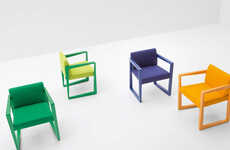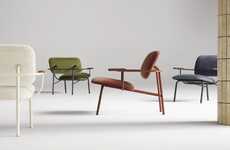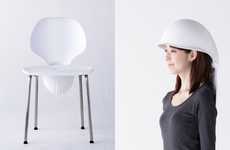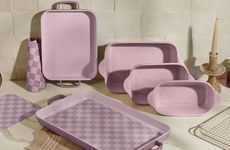
The U Chair by Assembly Design Focuses on Different Textures
Meghan Young — May 22, 2014 — Art & Design
References: assemblydesign.us & fastcodesign
The 'u' in the name of the U Chair could as easily refer to the word 'unique' as it does to its frame. Not only does the tall backrest give the U Chair an unusual silhouette, it is made up of a variety of materials that focus on different textures. For instance, the backrest is made out of leather, the seat is cushioned with a sheep shearling while the frame itself is fashioned out of wood.
Designed by Assembly Design, a product studio based in New York City, in collaboration with New Friends, the U Chair is inspired by traditional craft methodologies that have been tweaked by using experimental processes. For instance, the leather backrest takes on a checkered weave pattern, which has been further distinguished with marbled strips of leather.
Designed by Assembly Design, a product studio based in New York City, in collaboration with New Friends, the U Chair is inspired by traditional craft methodologies that have been tweaked by using experimental processes. For instance, the leather backrest takes on a checkered weave pattern, which has been further distinguished with marbled strips of leather.
Trend Themes
1. Unique Silhouette - Designing furniture with unusual backrest shapes and a mix of textures offers opportunities for disruptive innovation in the home decor industry.
2. Experimental Processes - Exploring new techniques and materials to create furniture designs with checkered weave patterns and marbled leather strips opens up possibilities for disruptive innovation in the furniture manufacturing industry.
3. Traditional Craft Methods - Reviving traditional craft techniques and combining them with modern design elements allows for disruptive innovation in the furniture industry by blending the old and new.
Industry Implications
1. Home Decor - Integrating unique and textured furniture designs into the home decor industry presents opportunities for disruptive innovation and enhanced customer experiences.
2. Furniture Manufacturing - Exploring experimental processes and materials in furniture manufacturing can lead to disruptive innovation, offering customers innovative and visually appealing products.
3. Craftsmanship - Applying traditional craft methodologies with a twist in furniture design creates opportunities for disruptive innovation in the craftsmanship industry by combining heritage with contemporary aesthetics.
0.5
Score
Popularity
Activity
Freshness























